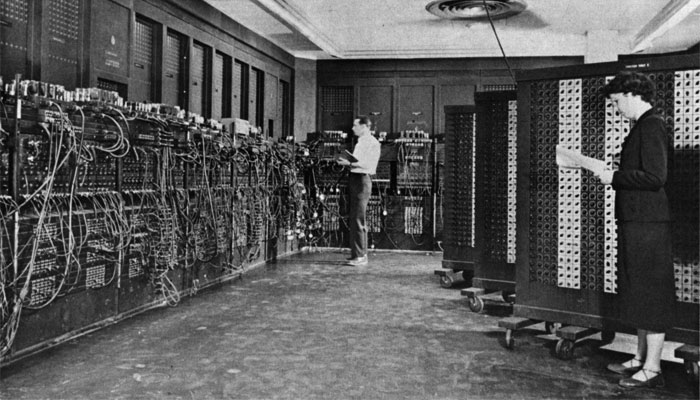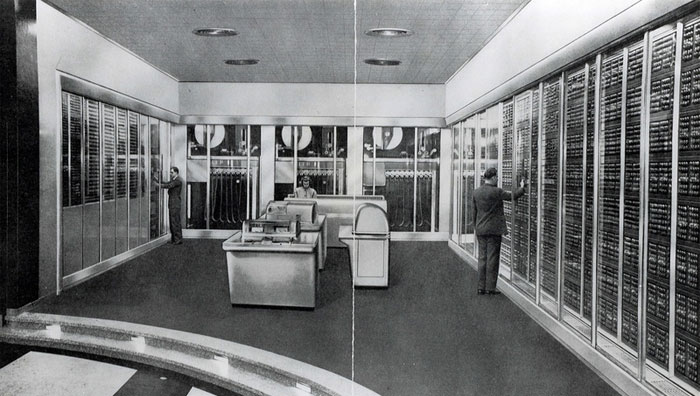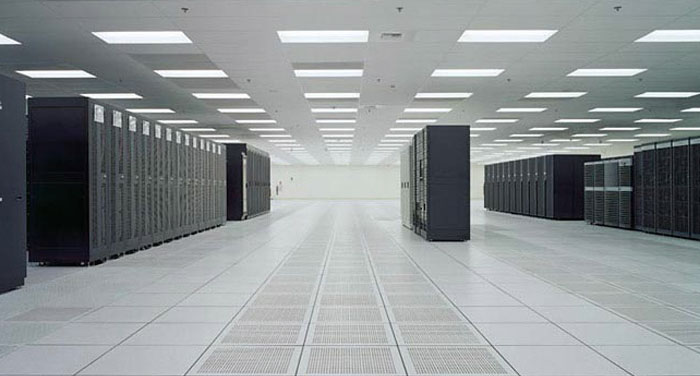Last week, Aaron, Joanne and I gave talks as part of an evening called “Stories from the New Aesthetic“, presented by Rhizome at the New Museum, New York. Aaron’s and Joanne’s notes are online, and a film will follow at some point. These are not my notes, but an elaboration of some of the points I raised during the talk.

Reading George Dyson’s Turing’s Cathedral, a broad overview of the early years of computers, I’ve been collecting quotes that discuss the physicality of the machine. This is mathematician Harry Reed writing about the ENIAC (above), the first electronic general-purpose computer, constructed at the University of Pennsylvania in 1942-6:
“The ENIAC itself, strangely, was a very personal computer. Now we think of a personal computer as one which you carry around with you. The ENIAC was actually one that you kind of lived inside.”
This was the nature of the mainframes. Machines you lived inside. I was fascinated too by this description:
Hippo was run on IBM’s Selective Sequence Electronic Calculator (SSEC), completed in 1948 and housed in a windowed showroom at their world headquarters on Fifty-seventh Street and Fifth Avenue in New York.
“Hippo” was one of the first calculations to determine the feasibility of a hydrogen bomb, by simulating simultaneously the processes of nuclear fission: neutron multiplication, radiation transportation, and hydrodynamics.
I’ve been trying to find the correct address for the SSEC, and it appears that it was housed not in the IBM building itself, but in a former ladies shoe store nearby (The French Bootery, according to this source, which would put it at 19 East 57th Street according to the Metropolitan Museum’s shoe collection. This address is now the headquarters of the LVMH group). The computer was installed on three walls, and plate glass opened it to the street. In this photo, supporting columns in the middle of the room has been airbrushed out:

That’s the first full simulatiom of a hydrogen bomb detonation, being run on a computer in a public showroom on 5th Avenue. Visible, but not legible. Unparseable.
Later, Dyson notes the surprising longevity of the von Neumann architecture, the arrangement of processing unit, control unit, memory, storage, and I/O mechanisms which remain at the heart of most modern computers:
The last thing either Bigelow or von Neumann would have expected was that long after vacuum tubes and cathode-ray tubes disappeared, digital computer architecture would persist largely unchanged from 1946. “The design of an electronic calculating machine,” [wrote Bigelow] “turns out to be a frustrating wrestling-match with problems of interconnectability and proximity in three dimensions of space and one dimension of time.”
This seems as good a time as any to post a picture of a modern mainframe, or supercomputer, in this case one of Simon Norfolk’s photographs, from the series “I’m sorry Dave, I’m afraid I can’t do that”.

This is a more modern IBM computer, the Blue Gene/L, which, as Norfolk notes, is in use at the Lawrence Livermore National Laboratory to further simulate the design and use of nuclear weapons.
I have written in the past about datacenters and carrier hotels as aesthetic objects and assemblages; they might also be considered supercomputers, the high-density nodes of the network, in which a select band of skilled engineers reside. Machines for living inside. (“The cloud” is a reversal of the trend over the last 50 years for evenly distributing contributing power to a myriad of devices; the effort now is to concentrate the processing, control, memory and storage into fewer (although still multiple, “virtual”) locations, while only input and output are properly distributed.)
Let’s follow that with this extended quotation from an interview with William Gibson in the Paris Review of Summer 2011, in answer to the question “where did Cyberspace come from?”:
I was painfully aware that I lacked an arena for my science fiction. The spaceship had been where science fiction had happened for a very long time, even in the writing of much hipper practitioners like Samuel Delany. The spaceship didn’t work for me, viscerally. I know from some interviews of Ballard’s that it didn’t work for him either. His solution was to treat Earth as the alien planet and perhaps to treat one’s fellow humans as though they were aliens. But that didn’t work for me. I knew I wouldn’t be able to function in a purely Ballardian universe. So I needed something to replace outer space and the spaceship.
I was walking around Vancouver, aware of that need, and I remember walking past a video arcade, which was a new sort of business at that time, and seeing kids playing those old-fashioned console-style plywood video games. The games had a very primitive graphic representation of space and perspective. Some of them didn’t even have perspective but were yearning toward perspective and dimensionality. Even in this very primitive form, the kids who were playing them were so physically involved, it seemed to me that what they wanted was to be inside the games, within the notional space of the machine. The real world had disappeared for them—it had completely lost its importance. They were in that notional space, and the machine in front of them was the brave new world.
The only computers I’d ever seen in those days were things the size of the side of a barn. And then one day, I walked by a bus stop and there was an Apple poster. The poster was a photograph of a businessman’s jacketed, neatly cuffed arm holding a life-size representation of a real-life computer that was not much bigger than a laptop is today. Everyone is going to have one of these, I thought, and everyone is going to want to live inside them. And somehow I knew that the notional space behind all of the computer screens would be one single universe.
So here we see the process of Gibson’s realisation that soon we would all be living inside these spaces, as the mainframe reduced down a PC; with the delightfully playful image of the arcade, Narnia-cupboard-like, as linking device. (The parallel: the number of contemporary geeks whose technological yearnings began in the primitive perspective of home consoles like the ZX Spectrum or Commodore 64.)
We used to posit this space, the network, the notional space, as being elsewhere, the other side of the screen. But increasingly we have these images of the machine as something that surrounds us, that we live inside, within. As something that enfolds us.

Writing about Where The F**k Was I?, I invoked the architecture of “the abstract machine: the digital networks, access points, substations and relay points, datacenters and fiber rings.” This should be extended up and out, to the 30-pointed star of the GPS system, a superstructure twenty-five thousand miles across that we are all living inside, even if its columns and pediments are invisible to the naked eye.
The “abstract machine” is Deleuze and Guattari’s term for the sum of all machines—in their terminology, this includes the body, society, language, interpretation: like the rhizome it stands both for the sum and its parts. So the network too is one of these abstract machines: a mainframe, a terminal, a laptop, a wireless LAN, a string of satellites. And us too, living inside the machine, a part of the network.
That notional space.
Comments are closed. Feel free to email if you have something to say, or leave a trackback from your own site.